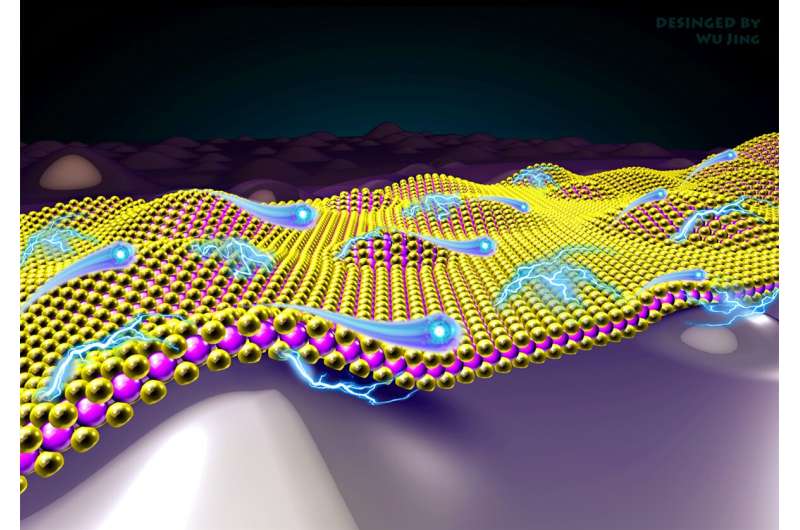Creating ripples in 2D material, molybdenum disulfide, was found to increase carrier mobility by two orders at room temperature, allowing electrons to move faster through the material. Credit: A*STAR's Institute of Materials Research and Engineering
Two dimensional (2D) semiconductors have a unique property that allows their thickness to be reduced to one or few atoms—and this property could potentially minimize the short channel effects that remain an issue in advanced silicon-based transistors, for example, turning on a transistor prematurely.
Despite the potential that 2D semiconductors possess in replacing conventional semiconducting materials like silicon in future, one key challenge remains: their low carrier mobility at room temperature, caused by strong scattering between electrons and phonons.
Road and traffic conditions determine the amount of time and energy that a person spends traveling from one location to another. In a similar fashion, carrier mobility measures how quickly a carrier, such as an electron or a hole, can move through a material when there is an electric field. This characteristic also determines whether a semiconducting material is suitable for electronic devices.
High carrier mobility can effectively reduce power dissipation in integrated circuits and lower the overall power consumption, thus prolonging the lifetime of electric devices or systems, as well as reducing the costs of running these devices or systems.
Researchers from the Agency for Science, Technology and Research's (A*STAR) Institute of Materials Research and Engineering (IMRE), Fudan University, National University of Singapore and The Hong Kong Polytechnic University have recently found that placing 2D materials on substrates with bulged morphologies can enhance carrier mobility at room temperature by two orders. These bulges create ripples in the material, thus distorting its lattice structure—moving one or more atoms from their original position in an ideal structure.
This approach contrasts conventional strategies which rely on perfect lattice structures to enhance carrier mobility, as any form of impurity or lattice distortion is regarded to adversely affect mobility.
In a study published in Nature Electronics in June 2022, researchers observed that rippled 2D molybdenum disulfide (MoS2) with lattice distortions create a larger electric polarization that can renormalize the frequency of phonons. This renormalized phonon frequency effectively reduces the strength of scattering between electrons and phonons, thus increasing carrier mobility in MoS2. This means that electrons can now move faster through the material.
Study results show that carrier mobility at room temperature is enhanced by two orders in rippled MoS2, reaching approximately 900 cm2 V-1 s-1. The observed result exceeds the predicted phonon-limited carrier mobility of flat MoS2 of 200–410 cm2 V-1 s-1.
Through the study, creating bulges in the lattice structure of MoS2 was found to overcome the intrinsic carrier mobility limit of the material. This paves the way for MoS2 and other 2D materials to be used in creating field-effect transistors and thermoelectric devices with competitive performance at room temperature.
"Our approach is simple and cost-effective, demonstrating lattice engineering as an effective strategy to create high-performance room-temperature electronics and thermoelectric devices for future electronics," said Dr. Wu Jing, Scientist at A*STAR's IMRE.
"We further reveal the underlying mechanism that the improved carrier mobility is due to the suppressed electron-phonon scattering and increased intrinsic dielectric constant induced by the rippled structures in the 2D semiconductor. Both of them play synergistic effects to boost the intrinsic carrier mobility," said Dr. Yang Ming, Assistant Professor at the Department of Applied Physics, The Hong Kong Polytechnic University.
More information: Hong Kuan Ng et al, Improving carrier mobility in two-dimensional semiconductors with rippled materials, Nature Electronics (2022). DOI: 10.1038/s41928-022-00777-z
Journal information: Nature Electronics
























